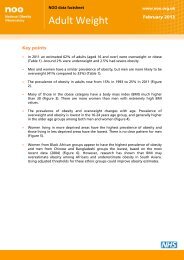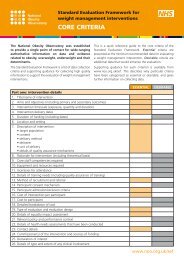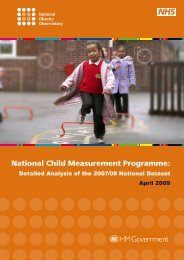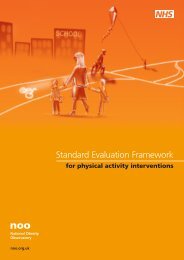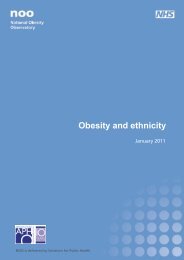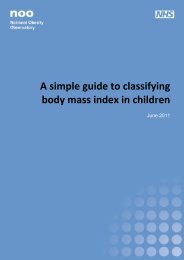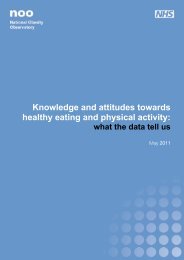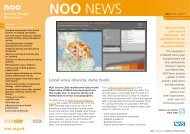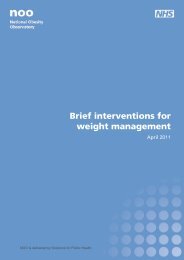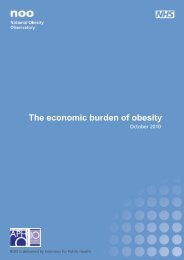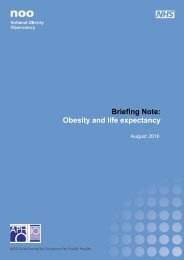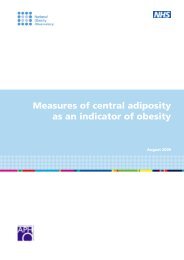Review of dietary assessment methods in public health - National ...
Review of dietary assessment methods in public health - National ...
Review of dietary assessment methods in public health - National ...
You also want an ePaper? Increase the reach of your titles
YUMPU automatically turns print PDFs into web optimized ePapers that Google loves.
OverviewThe CDQ is a 28-item semi-quantitative food frequency questionnaire that has beendesigned to be self-completed by parent or caregiver (with or without researcherassistance). It calculates four different food-group scores, which <strong>in</strong>clude:• a fruit and vegetable score;• a fat from dairy products score;• a non-core foods h score; and• a sweetened beverages score.A variety <strong>of</strong> different response-scales are used <strong>in</strong>clud<strong>in</strong>g Likert scales and frequencyscales.Items were <strong>in</strong>cluded <strong>in</strong> the questionnaire based on their perceived impact on the<strong>health</strong>fulness <strong>of</strong> a diet, and whether their <strong>in</strong>take is generally ‘recommende’ or‘discouraged’. Secondary analysis <strong>of</strong> nationally representative children’s <strong>in</strong>take datawas undertaken to identify food patterns that dist<strong>in</strong>guish higher and lower qualitydiets. To ensure that <strong>in</strong>clusion <strong>of</strong> all types <strong>of</strong> relevant foods were <strong>in</strong>cluded <strong>in</strong> thequestionnaire and to optimise content validity, a panel <strong>of</strong> four paediatric <strong>dietary</strong>experts reviewed all items.Validation and reliabilityParents were asked to complete a 7-day checklist alongside the CDQ to check if the toolwas provid<strong>in</strong>g an accurate account <strong>of</strong> <strong>dietary</strong> <strong>in</strong>take. Items on the checklist mirroredthe food and dr<strong>in</strong>k items conta<strong>in</strong>ed <strong>in</strong> the CDQ. This process found that that thequestionnaire was not able to accurately dist<strong>in</strong>guish positive or negative <strong>dietary</strong> riskbased on CDQ scores at an <strong>in</strong>dividual child level. This suggests that the CDQ has validityas a tool to assess <strong>dietary</strong> patterns at a group or population level (for which it wasdesigned) but not as an <strong>assessment</strong> <strong>of</strong> <strong>dietary</strong> <strong>in</strong>take <strong>in</strong> cl<strong>in</strong>ical one-to-one sett<strong>in</strong>gs. Thereadability <strong>of</strong> the questionnaire was assessed by pilot test<strong>in</strong>g a draft form with fourparents.The questionnaire was used <strong>in</strong> five different studies us<strong>in</strong>g different population groupsto exam<strong>in</strong>e different parameters <strong>of</strong> the questionnaire. The <strong>in</strong>tra-class correlationcoefficient (ICC) between the first and second adm<strong>in</strong>istrations <strong>of</strong> the questionnaire wasused to exam<strong>in</strong>e reliability. Test-retest reliability values were significant for allsubscales: 0.75 for fruit and vegetables; 0.51 for fat from dairy products; 0.55 forsweetened beverages; and 0.90 for non-core foods.In one study, children were recruited onto a weight management programme thatencouraged a change <strong>in</strong> eat<strong>in</strong>g patterns closer to those recommended by Australian<strong>dietary</strong> guidel<strong>in</strong>es. Significant differences were reported for all sub-scales betweenbasel<strong>in</strong>e and at six months <strong>in</strong> the expected direction, i.e. an <strong>in</strong>crease <strong>in</strong> fruit andvegetable score and decreases <strong>in</strong> fat from dairy, sweetened beverages and non-corefoods scores. This outcome suggests that the questionnaire can be used to detect<strong>dietary</strong> change, but further test<strong>in</strong>g is needed to confirm its ability to detect bothdirection and magnitude <strong>of</strong> change.hPeanut butter or Nutella, pre‐sugared cereals, sweet biscuits/cakes/muff<strong>in</strong>s/doughnuts/fruit pies, potatochips/crisps or savoury biscuits, confectionery/ muesli or fruit bars, chocolate, s<strong>of</strong>t dr<strong>in</strong>k/cordial, icecream/Ice‐blocks,pie/pasty/sausage roll, pizza, hot chips/French fries, hot dog/processed meats, takeawayNOO | <strong>Review</strong> <strong>of</strong> <strong>dietary</strong> <strong>assessment</strong> <strong>methods</strong> <strong>in</strong> <strong>public</strong> <strong>health</strong> 25



